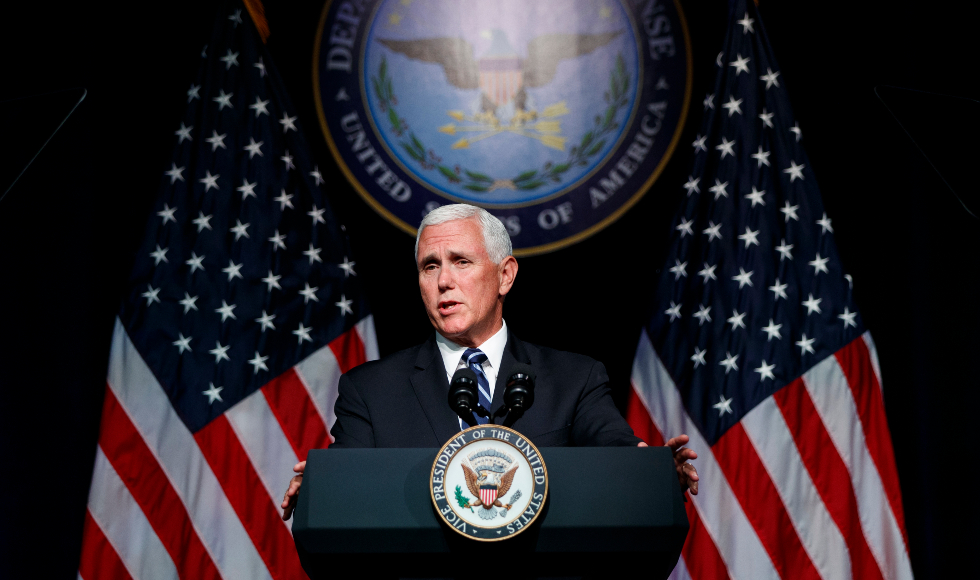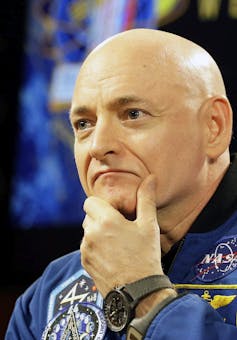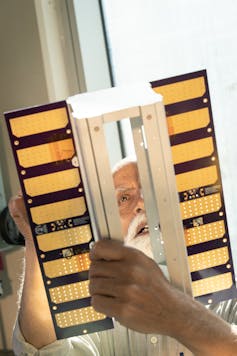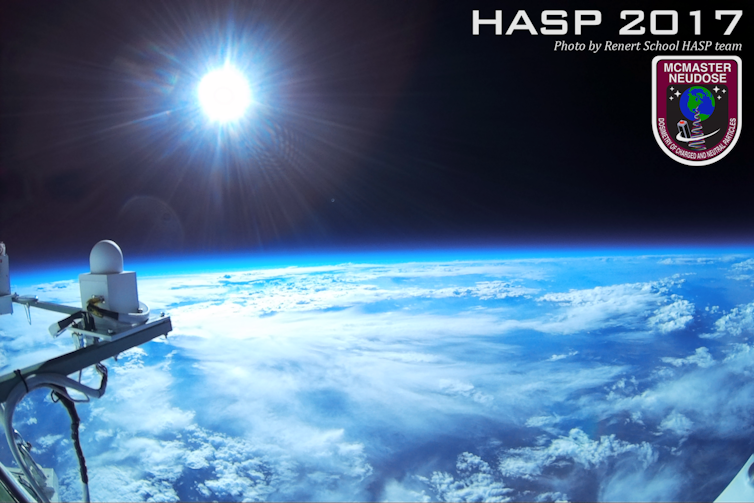How Canadian technology could help protect Space Force troops

U.S. Vice-President Mike Pence speaks about the creation of a United States Space Force on Aug. 9, 2018 at the Pentagon. (AP Photo/Evan Vucci)
BY Fiona McNeill
August 17, 2018
U.S. Vice-President Mike Pence has announced that the United States plans to establish a “Space Force.” President Donald Trump endorsed the announcement in a follow-up tweet.
Space Force all the way!
— Donald J. Trump (@realDonaldTrump) August 9, 2018
The response was mixed: Some support, some pushback. The topic also became fodder for late-night TV shows.
The U.S. says it’s establishing Space Force as a response to perceived threats to American space hardware from Russia and China. Both countries have been developing high-powered lasers to knock out communications equipment on satellites. The U.S. government is taking a number of space threats seriously; hence the desire for space military capability.
It was not clear from Pence’s announcement whether troops would actually be sent to space, but fundraising emails from the Trump campaign included the logo “Mars awaits.”
This suggests support for plans to send humans to our neighbouring planet. But the journey to Mars will be perilous.
Protecting astronauts from radiation
I am a professor of radiation physics and a co-investigator on a team that is launching a new satellite to look into radiation doses in space. I know that one of the big space exploration challenges is how to protect astronauts and troops from high radiation fields in space.

Past astronauts were found to have a higher risk of cataracts, for example. Last year, Scott Kelly found that his DNA profile was no longer the same as his twin after a year in space.
A trip to Mars (and back) would take years, and astronauts and troops would be subjected to substantial radiation doses. We don’t yet fully understand all of the radiation risks from space travel.
On Earth, we are bombarded with radiation from space, but we have the Earth’s magnetic field and our atmosphere to protect us.
Fly or travel up a mountain, and you’ll be exposed to more radiation, because there is less atmosphere between you and space. Once outside the atmosphere, space travellers will be exposed both to higher levels of radiation and to different types of radiation than at sea level.
Space Force fighters would be exposed to higher fields of neutrons, protons and heavy ions, including the ionized atoms of helium and even iron. Some of the radiation comes from supernovae outside of our solar system and some comes from occasional high bursts of energetic solar particles from our sun.
A portion of the radiation exposure will be a result of interactions of particles with the space craft materials. The radiation field changes over time, and also varies with location in space.
Cancer, cataracts
Radiation can result in biological and health effects because it can directly damage DNA or cause build-up of toxic molecules, like hydrogen peroxide, inside cells. Studies of the survivors of the atomic bombs in Hiroshima and Nagasaki found increased levels of cancer and a higher incidence of cataracts in people exposed to high levels of radiation.
Troops sent to Mars could receive doses comparable to some atom bomb survivors, although at a slower rate over a longer period of time. However, some could be exposed to heavy charged particles that are more densely ionizing than X-rays. Heavy charged particles have a more significant biological impact relative to X-rays because they deposit more energy, in shorter tracks, as they pass through human cells.

It will be important for Space Force to monitor radiation fields in real time, so that troops can don suits with radiation shielding or move to shielded areas of spacecraft for protection during high radiation episodes.
This is where Canadian technology may play a future role. I am one of the co-investigators in the NEUDOSE satellite team. We are a multidisciplinary student team from the Faculties of Engineering and Science at McMaster University who are designing and building a novel radiation detector that we plan to test in space.
The detector will be mounted in a small satellite — about the size of a loaf of bread — known as a CubeSat.
If we meet our mission goals, our satellite will be launched from the International Space Station by the Canadian Space Agency in 2021. We have already completed one successful balloon mission using NASA’s High Altitude Student Platform (HASP).
Detector launched into space
In 2017, the detector was launched 34 kilometres above the Earth on a zero pressure, 11-million-cubic-foot, helium-filled balloon from Fort Sumner, New Mexico.

This September, the detector will be tested inside the CubeSat on a second NASA HASP launch. Our team plans to test our ground receiving station by mounting it on a truck and driving over the New Mexico countryside, chasing the balloon test. We hope to confirm that we can receive test signals from our satellite back on the ground.
The novelty of our radiation detector is that it will, through an ingenious design first proposed by Andrei Hanu, a senior scientist at Bruce Power, simultaneously measure in real time both charged and neutral particles and distinguish them.
The detector is based on designs that are being developed at McMaster by Prof. Soo Hyun Byun for radiation protection in the nuclear industry, adapted for space radiation.
Launching the detector on a CubeSat allows us to test the detector performance in space, and will also provide several months of data of the space radiation fields in near-Earth orbits after launch.
The satellite will orbit for nine to 12 months. Every time it passes over McMaster, it will beam back radiation data to a ground station. That data should allow improvements to be made to current radiation modelling tools that will help the planning for future missions into deep space, including Mars.
A new era of space exploration
The NEUDOSE team members, myself included, truly believe that humanity is entering a new era of exploration. Human beings may soon fly on missions back to the moon and out to Mars.
Our hope is that our radiation instrument could ultimately replace current equipment on the International Space Station and be used on future space craft to identify high-dose areas in space and incoming solar storms.
And who knows? Maybe our detectors will be installed on the first Space Force deep space mission vehicles.
Fiona E. McNeill, Professor of Radiation Sciences, McMaster University
This article was originally published on The Conversation. Read the original article.


